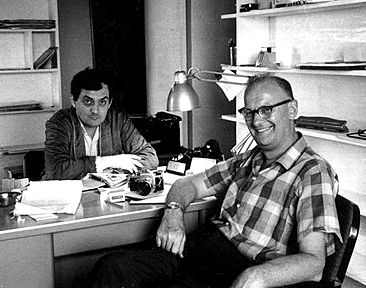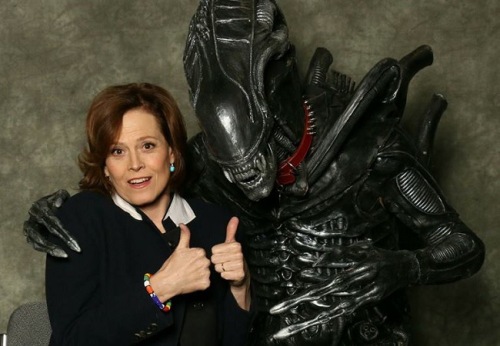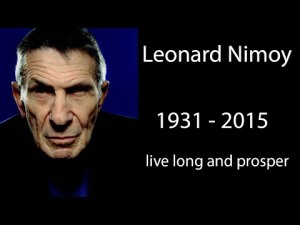All About The “Ultimate Trip.”
“I think there were two problems with the design of anything [in 2001]. One was, ‘Is there anything about it that would be logically inconsistent with what people felt would actually exist?’ and the other one was, ‘Would it be interesting? Would it look nice?'” – Stanley Kubrick.
Fresh from the success of Dr. Strangelove in 1964, Stanley Kubrick considered creating the definitive SF movie, drawing on the latest discoveries. At that time, Arthur C. Clarke (1917-2008) was extraordinarily talented in both fields of science fiction and science. Having set out to use his “imagination to do something about reality,” he achieved this by creating the concept of the communications satellite, so he was the ideal boffin with which Kubrick felt he could collaborate.
The director started the collaboration with the writer in April of that year. They took one of the latter’s short stories: “The Sentinel” (1950: about the discovery of an alien pyramid on the Moon) as the basis for crafting an ambitious science fiction epic. As it lasted only six pages, the pair spent the next two years developing the work into a novel which, in turn, would be converted into a screenplay – the basis for creating the ultimate “visual experience.”
Kubrick contacted Chesley Bonestell, then a highly-sought Hollywood matte painter and illustrator who had worked on Destination Moon (1950) and Conquest of Space (1955) just two of the numerous “space movies” the formidable pair viewed, in order to get the feel of what SF cinema could be like. Bonestell had, in 1952, also illustrated an eight-part series of articles for Collier’s magazine, focussing on the possibilities of space exploration.
They were certainly not impressed with what was already on offer. Clarke noted that the director was “highlly critical of everything,” with particular attention to “the poor quality of the design and special effects and the puerility of the scripts.” They decided that they had to be the instigators of an unprecedented, more respectable, dynamic form of SF cinema…
With all the creative talent at his beck and call, Kubrick opined that there “would not be any room left for my imagination.” Shooting began in December 1965, and with that, “Journey Beyond The Stars” was born.
“[Clarke] mentioned that he was working with director Stanley Kubrick on a film which aimed to be the science fiction, one which would be serious, scientifically plausible and big budget. It would involve other intelligences in space…” – Frederick I. Ordway III.
In January 1965, the pair met Frederick I. Ordway III (writer) and Harry (Hans-Kurt) Lange (artist), who both worked for the NASA George C Marshall Spaceflight Center in Huntsville, Alabama. In the director’s penthouse in New York City they discussed not only rocket science, but ballistic missiles, computers and aliens. In the next few days, Kubrick made a deal to with General Aeronautics to secure their valuable advisory services. Their boss: Werner von Braun did not seem to mind…
The first scene to be shot was the spine-chilling Dawn of Man sequence. The ape costumes and make-up were supplied by Stuart Freeborn (responsible fer all three characters played by Peter Sellers in Dr. Strangelove). When a tribe of apes awake to discover the Monolith while the terrifying music by Grigory Ligeti plays, still stands as one of cinema’s most fabulous – not to mention frightening – moments of all time.
When the dominant ape hurls a bone into the sky, so it transmogrifies into a gently descending spacecraft, thus catapulting the viewer millions of years onwards – a truly magical edit. There is a fascinating story connected to how The Blue Danube Waltz by Johann Strauss came to be used for that spaceflight sequence. Apparently, Kubrick just happened to be listening to that piece of classical music while editing that very scene, and realised that it would make a fine musical accompaniment for the images. Whatever the background, this sequence forever remains a sumptuous audio/visual delight.
Technical designs for the space wheel under construction in space (based on one of Bonestell’s original Collier’s illos), the Orion passenger cruiser and the Moon shuttle Aries were all approved by NASA. This work paved the way for all subsequent model-effects work we have watched in subsequent (pre-CGI) extravaganzas. This made up an estimated $6.5 million of the $10 million budget. Then, amid all the post-production mayhem, the title was changed to: 2001: A Space Odyssey…
“We were interested in starting where Destination Moon finished…” – Arthur C. Clarke.
For the final act concentrating on the Discovery mission to Jupiter, the model of the Discovery ship itself was the largest constructed for the film, said to have measured 54 feet in length. It is not surprising to learn that it never moved; to create the motion shots, it was the camera that moved.
The centrifuge was the largest set, at 38 feet high… and it revolved. All “props” had to be bolted to the floor, while the lighting and camera(s) operated non-stop. Kubrick remarked: “The Centrifuge set was made in such a way that that it had the structural integrity to preserve itself while the frame was rotated.”
Of the climactic hallucinogenic trip which culminates in Bowman hurtling through the timegate, until finding himself in a pristine mansion, yes, there were several cases of people taking strange substances. MGM recognised that particular audience by adding the tagline: “The Ultimate Trip” on posters. There are no reports of what both Kubrick and Clarke made of these individuals…
People have sought to question the movie’s claim to masterpiece status by stating how agonisingly incomprehensible 2001: A Space Odyssey really is. Plenty of critics – professional and amateur alike – set out to offer explanations for baffled cinema-goers to mull over, but “usually they were as verbose and wrong-headed as the film was clear thinking and sleek.”
In 1968, when Arthur C. Clarke was asked by a journalist what the film was about, he replied: “I don’t know. Ask Stanley Kubrick!” On the other side of the world, Kubrick was being asked the same question: “I don’t know,” he replied. “Ask Arthur Clarke!”




























